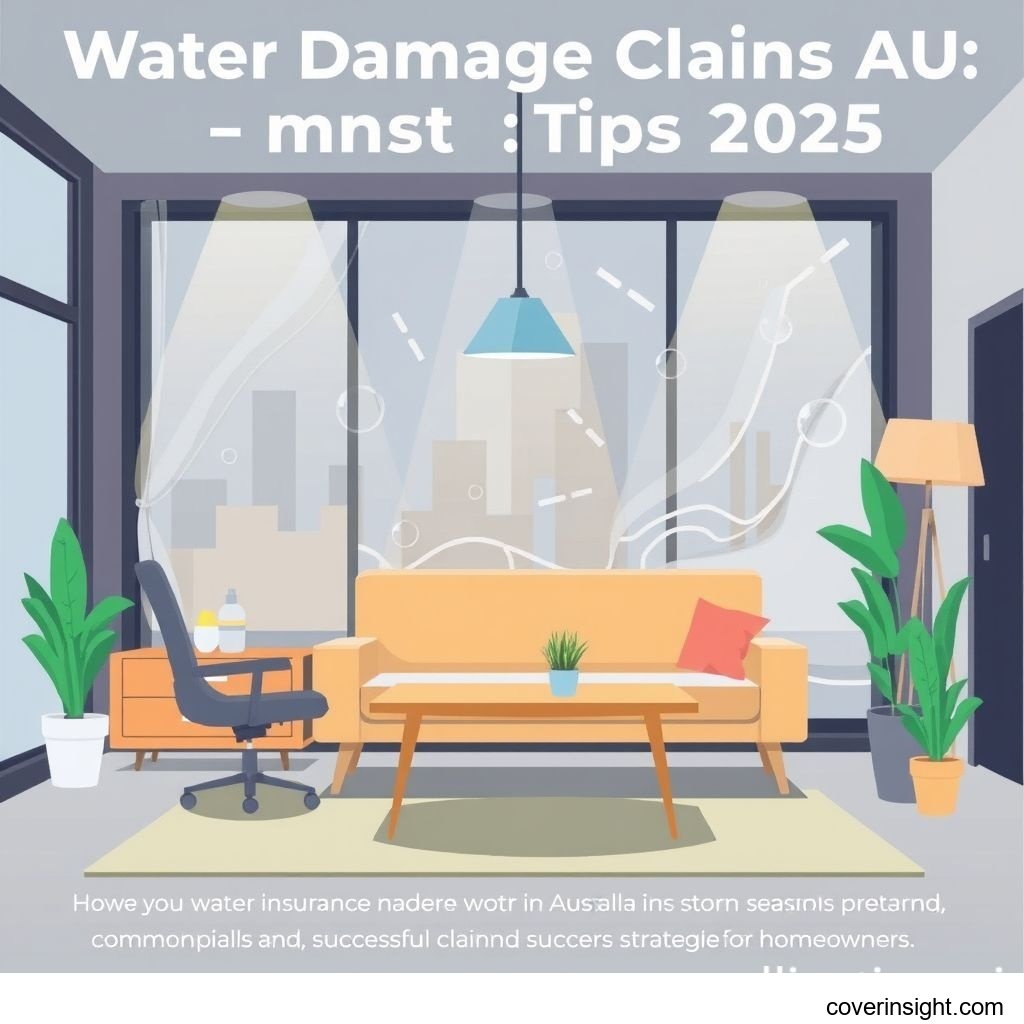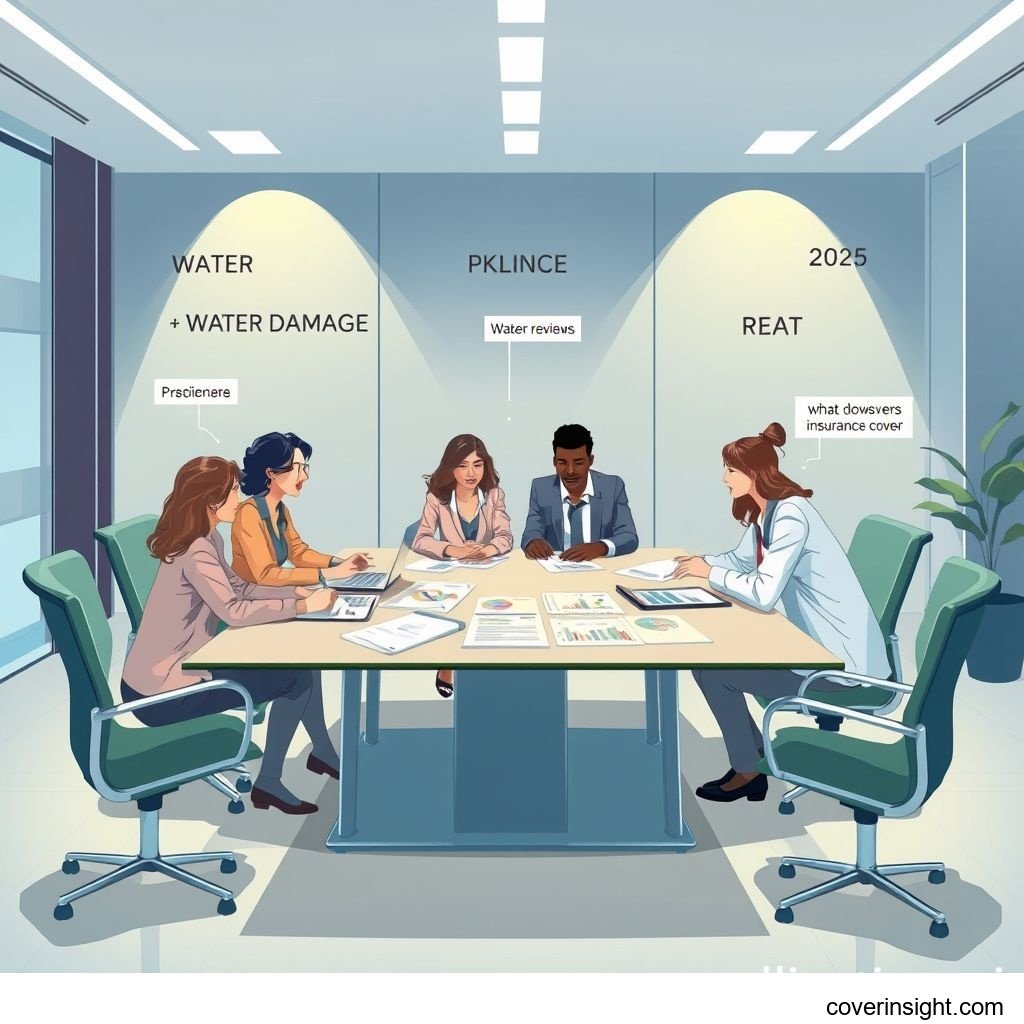Introduction
As 2025 unfolds, Australian homeowners face an evolving landscape of risks, from the impacts of climate change to the increasing complexity of property maintenance. Understanding what does homeowners insurance cover is not just a financial safeguard; it's a critical component of peace of mind. This comprehensive guide delves into the specifics of homeowners insurance in Australia, with a particular focus on navigating water damage claims. By equipping yourself with smart tips and detailed knowledge, you can ensure your most valuable asset is adequately protected against unforeseen events.
Understanding What Does Homeowners Insurance Cover in Australia
Homeowners insurance in Australia is designed to protect your property and belongings from a range of perils. It’s essential to grasp the nuances of your policy, especially when considering what does homeowners insurance cover in the context of specific risks like water damage. This section will outline the typical inclusions and common exclusions you should be aware of.
What’s Typically Included in Coverage
A standard homeowners insurance policy generally provides protection for both your building and contents against various incidents. Here’s a breakdown of what does homeowners insurance cover for most Australian properties:
-
Building Coverage: This part of your policy protects the physical structure of your home, including its walls, roof, floors, fixtures, and fittings. It also typically extends to permanent structures on your property like garages, sheds, fences, and swimming pools. Covered events often include:
-
Fire and smoke damage
-
Storms, including hail and strong winds
-
Floods (though often a separate or optional add-on, especially for defined flood events)
-
Impact by vehicles or falling trees
-
Burglary and vandalism
-
Explosions
-
Some forms of water damage (e.g., burst pipes, overflowing appliances – discussed in detail below)
-
-
Contents Coverage: This protects the personal belongings inside your home. This can range from furniture, appliances, and electronics to clothing and jewellery. It's vital to correctly estimate the value of your contents to ensure adequate coverage.
-
Liability Coverage: A crucial aspect of what does homeowners insurance cover is personal liability. This protects you financially if someone is injured on your property, or if you accidentally cause damage to someone else’s property. It covers legal costs and compensation that might be awarded.
-
Temporary Accommodation: If your home becomes uninhabitable due to an insured event, many policies will cover the cost of temporary accommodation while repairs are underway.
Ensuring your policy reflects the true replacement value of your home and contents is paramount. For general guidance on insurance resources, consider visiting Insurance Resources Global.
Common Exclusions and Limitations
While it’s vital to know what does homeowners insurance cover, understanding its limitations is equally important. Exclusions are specific events or circumstances that your policy will not cover. Common exclusions often include:
-
Wear and Tear: Damage caused by gradual deterioration, lack of maintenance, or neglect (e.g., rotten timber, rust) is typically not covered.
-
Pest Infestation: Damage from termites, rodents, or other pests is generally excluded.
-
Acts of War or Terrorism: These events are almost universally excluded from standard policies.
-
Uninsured Perils: Events not specifically listed as covered perils in your policy wording.
-
Pre-existing Damage: Any damage that existed before the policy started.
-
Certain Types of Water Damage: While burst pipes are often covered, certain forms of water damage can be excluded:
-
Gradual Leaks: Slow leaks that cause damage over time, which could have been prevented with maintenance, are often not covered.
-
Flood Damage: Standard policies historically excluded flood coverage. While this has changed for some insurers to offer it as an opt-in or standard inclusion, it's crucial to check if your policy explicitly includes "defined flood" cover.
-
Storm Surge: Damage from storm surge (ocean water being pushed inland by a storm) can sometimes be distinct from general flood cover.
-
Groundwater Seepage: Water seeping up through the ground or foundations due to heavy rain.
-
Always read your Product Disclosure Statement (PDS) carefully to understand the full scope of what does homeowners insurance cover and, critically, what it does not.
Navigating Water Damage Claims in Australia
Water damage is one of the most common and costly types of claims for Australian homeowners. Knowing the specific types of water damage covered and the correct steps to lodge a claim can significantly streamline the process.
Types of Water Damage Covered
When assessing what does homeowners insurance cover regarding water damage, clarity is key. Policies typically distinguish between sudden and accidental water damage versus gradual damage.
-
Sudden and Accidental Water Damage: This is generally covered. Examples include:
-
Burst pipes (e.g., a pipe suddenly ruptures behind a wall).
-
Overflowing bathtubs, washing machines, or dishwashers.
-
Hot water system failures leading to water leaks.
-
Storm-related water entry (e.g., rain entering through a damaged roof or window during a storm).
-
-
Hidden Water Damage: Some policies offer coverage for hidden damage caused by leaks over time, provided the leak itself was hidden and accidental (e.g., a slow leak inside a wall that only becomes apparent when significant damage is done). This varies significantly by insurer.
-
Flood Damage: As mentioned, true "flood" (the inundation of normally dry land by water escaping or released from the normal confines of any lake, river, creek, or other natural watercourse, or any canal, channel, drain, dam, or storm water channel) is often an optional extra or explicitly defined. It's crucial to confirm if your policy includes flood cover, especially if you live in a flood-prone area. You can find more information on industry standards from the Insurance Council of Australia.
Steps to Lodge a Successful Claim
If you experience water damage, acting promptly and systematically is vital for a smooth claim process. Here are the steps to lodge a successful claim:
-
Stop the Source: Your absolute first priority is to prevent further damage. If it's a burst pipe, turn off your main water supply. If it’s storm-related, take reasonable steps to mitigate entry (e.g., temporary tarping).
-
Ensure Safety: Be aware of electrical hazards. If water has reached power outlets or appliances, turn off the power at the main switch.
-
Document the Damage: Take extensive photos and videos of the damage before any cleanup or repairs begin. Document the source of the water, the extent of damage to the building, and damaged contents.
-
Contact Your Insurer Immediately: Notify your insurance company as soon as possible. Have your policy number ready. They will guide you on the next steps, including whether to undertake emergency repairs and whether an assessor will be dispatched.
-
Prevent Further Damage: Once the source is stopped and documented, take reasonable steps to prevent further damage. This might include drying out affected areas, removing wet items, or professional water extraction. Keep receipts for any emergency costs incurred.
-
Provide Requested Information: Your insurer will likely ask for details, photos, and possibly quotes for repairs. Be thorough and honest.
-
Cooperate with Assessors: An insurance assessor will evaluate the damage. Provide them with access and all requested documentation.
-
Review the Outcome: Understand the assessment, the scope of repairs, and any settlement offers. Don't hesitate to ask questions if anything is unclear.
Smart Tips for 2025 Claims
Staying proactive can significantly improve your claim experience for 2025 and beyond.
-
Understand Your Policy Limits: Know your sum insured for building and contents, and any specific limits for items like jewellery or art.
-
Maintain Your Property: Regular maintenance, such as checking pipes, cleaning gutters, and ensuring proper drainage, can prevent many water damage issues and demonstrate due diligence to your insurer.
-
Emergency Contact List: Keep your insurer's contact details, emergency plumbers, and electricians readily accessible.
-
Digital Inventory: Maintain a digital inventory of your valuable possessions, including receipts and photos. This significantly speeds up contents claims.
-
Professional Advice: If dealing with extensive damage, consider engaging professional water damage restoration services. Their reports can be invaluable for your claim.
-
Review Coverage Annually: As the value of your home and contents changes, and as risks evolve, it’s wise to review what does homeowners insurance cover annually to ensure it remains adequate.
Cost Analysis: What Does Homeowners Insurance Cover & Its Price?
The cost of homeowners insurance varies widely across Australia. Understanding the factors that influence premiums and knowing how to potentially reduce your costs can make a significant difference. It's not just about what does homeowners insurance cover, but also about its affordability.
Key Price Factors Influencing Premiums
Several variables determine the price you pay for your homeowners insurance premium:
-
Location: Postcode plays a huge role. Areas prone to natural disasters (bushfires, floods, cyclones), high crime rates, or coastal erosion will typically have higher premiums.
-
Building Type and Age: The construction materials (brick, timber, steel), age of the property, and its overall condition impact risk. Newer homes or those built with more resilient materials may incur lower premiums.
-
Sum Insured: The higher the value you insure your building and contents for, the higher your premium will be. Ensuring accurate replacement costs is vital.
-
Excess Amount: The excess is the amount you pay towards a claim. Opting for a higher excess generally leads to a lower premium, but means a larger out-of-pocket expense if you claim.
-
Security Features: Homes with security systems, deadlocks, alarm systems, or even living in a gated community can sometimes attract discounts.
-
Claim History: A history of previous claims, particularly frequent ones, can lead to increased premiums.
-
Optional Extras: Adding specific covers like accidental damage, flood, or motor burnout protection will increase your premium.
-
Insurer and Policy Type: Different insurers have different risk appetites and pricing models. Comprehensive policies will naturally cost more than basic ones.
For those interested in understanding the broader regulatory landscape influencing insurance pricing in Australia, the Australian Prudential Regulation Authority provides valuable insights.
Strategic Saving Tips for Homeowners
While you can't control all factors, there are several ways to potentially reduce the cost of what does homeowners insurance cover:
-
Shop Around Annually: Don't just auto-renew. Get quotes from multiple insurers each year. The market is competitive, and new deals emerge frequently.
-
Increase Your Excess: If you can comfortably afford a higher out-of-pocket expense in the event of a claim, increasing your excess can significantly lower your annual premium.
-
Bundle Policies: Many insurers offer discounts if you bundle your home, car, and other insurance policies with them.
-
Improve Home Security: Installing an alarm system, security cameras, or upgrading locks can sometimes lead to discounts.
-
Maintain Your Property: A well-maintained home is less risky. Keeping gutters clear, repairing leaks promptly, and ensuring the roof is in good condition can reduce the likelihood of claims, which can indirectly help keep premiums stable over time.
-
Review Your Sum Insured: Regularly reassess the replacement value of your building and contents. You might be over-insuring, or conversely, under-insuring, which could lead to heartache at claim time.
-
Pay Annually: If possible, pay your premium annually rather than monthly, as some insurers charge a fee for monthly instalments.
Broader Financial Planning: Beyond Homeowners Insurance
While understanding what does homeowners insurance cover is paramount for property owners, a comprehensive financial strategy often extends far beyond your home. Considering all life stages, individuals might also need to explore options for retirement planning insurance to secure their future financial stability, alongside other forms of protection. Similarly, for families with younger members, robust student insurance guidance can be crucial, covering everything from health to travel for those pursuing education away from home. These aspects of financial planning ensure holistic protection across different phases of life.
Future Trends and Broader Considerations
The insurance landscape is constantly evolving. Staying informed about emerging trends can help you make more astute decisions about what does homeowners insurance cover and how it adapts to future challenges.
Adapting to Climate Change Risks
Australia is particularly vulnerable to the impacts of climate change, leading to more frequent and intense natural disasters. Insurers are adapting by:
-
Refining Risk Assessments: Using advanced data analytics and climate models to assess property-specific risks more accurately, which can influence premiums.
-
Promoting Resilience: Some insurers offer discounts or incentives for homes that adopt mitigation measures, such as strengthening against cyclones or elevating properties in flood zones.
-
Evolving Coverage: The definitions and availability of flood and bushfire cover are continually reviewed and refined by the industry in response to changing climate patterns.
The Role of Technology in Claims
Technology is transforming how homeowners insurance claims are managed:
-
Drones and Satellite Imagery: Used for rapid initial damage assessment after widespread events, allowing insurers to identify affected properties quickly.
-
AI and Machine Learning: Streamlining claim processing, identifying fraud, and personalising customer interactions.
-
Smart Home Devices: Devices like leak detectors can provide early warnings, potentially preventing major water damage, and some insurers may offer incentives for their use.
-
Digital Claim Portals: Making it easier for policyholders to submit claims, upload documentation, and track progress online.
Holistic Financial Protection: Retirement and Student Insurance
Beyond protecting your home, comprehensive financial security involves looking at the full spectrum of your life's journey. For many, integrating retirement planning insurance into their long-term financial strategy is critical, offering peace of mind about income streams and living expenses in later years. This often includes life insurance, income protection, and critical illness policies tailored for post-career security.
Moreover, for families, navigating the complexities of education can be simplified with proper student insurance guidance. This ensures that students, whether studying locally or abroad, are covered for health emergencies, personal liability, and even travel disruptions. Understanding these diverse insurance products is just as important as knowing what does homeowners insurance cover for a truly secure future.
FAQs: What Does Homeowners Insurance Cover?
Navigating the world of insurance can be daunting. Here are answers to some of the most frequently asked questions about what does homeowners insurance cover in Australia.
-
How much does what does homeowners insurance cover cost?
The cost varies significantly, typically ranging from a few hundred to several thousand dollars per year. Factors like location, property value, claims history, and chosen excess all influence the premium. It's crucial to get multiple quotes to find a competitive price for what does homeowners insurance cover.
-
What affects premiums?
Premiums are affected by numerous factors, including your property's location (risk of natural disasters, crime rates), age and construction of your home, the sum insured for building and contents, your chosen excess, any security features, and your past claims history. The specific coverage elements you select also play a major role in what does homeowners insurance cover and its associated cost.
-
Is it mandatory?
No, homeowners insurance is not legally mandatory in Australia. However, if you have a mortgage, your lender will almost certainly require you to have building insurance to protect their financial interest in the property. While contents insurance is optional, it's highly recommended.
-
How to choose?
Choosing the right policy involves comparing quotes from multiple insurers, carefully reading the Product Disclosure Statement (PDS) to understand inclusions and exclusions, assessing your specific coverage needs (e.g., flood cover if in a high-risk area), considering your budget, and looking at the insurer's customer service and claims reputation. Focus on what does homeowners insurance cover relative to your property’s specific risks.
-
Consequences of no coverage?
Without homeowners insurance, you bear the full financial burden of any damage to your property or contents, or any liability claims. This could lead to devastating financial loss, particularly after major events like fires, storms, or significant water damage, leaving you without the means to repair or rebuild. This underscores the importance of understanding what does homeowners insurance cover before an incident occurs.
Conclusion
Understanding what does homeowners insurance cover in Australia in 2025 is more crucial than ever. From protecting against common perils like water damage to navigating the complexities of claims, a well-informed approach ensures your property and financial wellbeing are secure. By carefully reviewing your policy, understanding exclusions, and implementing smart tips for claims, you can safeguard your home effectively. Remember, homeowners insurance is not just a policy; it's an investment in your peace of mind, allowing you to face the future with confidence.








Comments